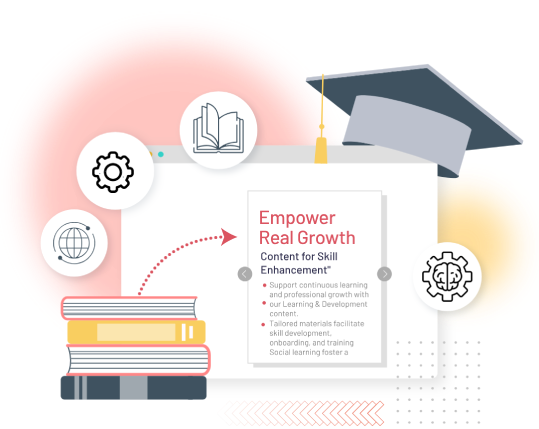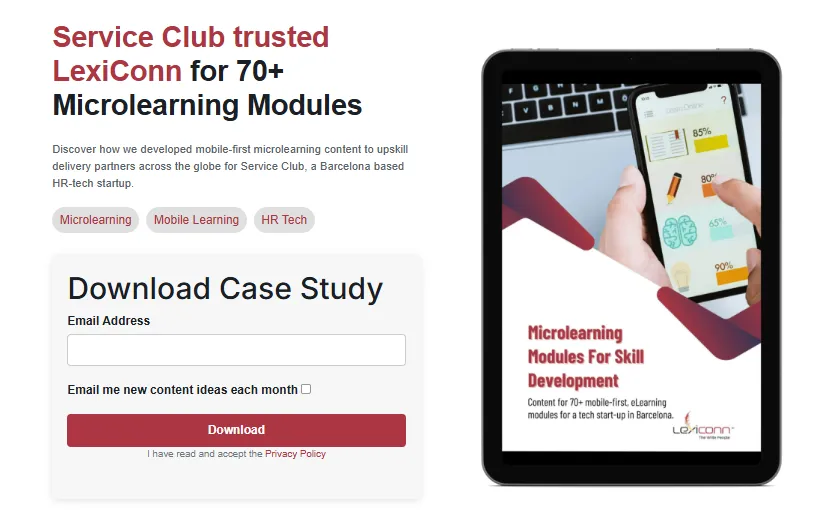

The eLearning industry is experiencing explosive growth. With billions of dollars invested in online education and training, it’s clear that this is no passing trend. However, despite the sheer scale of eLearning adoption, the statistics are alarming. This stark reality has raised a critical question: Why is engagement still such a challenge?
The problem isn’t just about delivering content; it’s about delivering content that relates and keeps learners motivated to continue. While course completion rates and learner satisfaction surveys can paint a positive picture, they don't necessarily speak to the effectiveness of the learning experience.
What if we’ve been measuring success based on the wrong metrics?
This blog will address how course development and content creation are evolving to tackle this crisis of engagement. It’s not enough to just throw in flashy interactive elements or a few gamified quizzes. It’s about fundamentally shifting how we think about eLearning—from a system of content delivery to a personalized, learner-centered experience.

The eLearning industry has come a long way since its early days. From static modules and textbooks to highly dynamic, learner-driven platforms, the evolution of eLearning is rooted in technology, pedagogy, and shifting learner expectations.
AI-driven personalization is revolutionizing course development. No longer are courses one-size-fits-all. Learners today expect content that adapts to their individual learning paths, providing them with recommendations based on their progress, interests, and prior knowledge.
Adaptive learning platforms that use AI to personalize learning experiences are significantly improving engagement by ensuring that content creation aligns with the learner’s pace and needs.
Gamification has moved beyond a buzzword. Incorporating game-like elements into eLearning courses is proven to improve motivation and retention. s no longer just about uploading hours of video content; it's about creating interactive, bite-sized modules that build a cohesive learning journey.
Using points, badges, leaderboards, and challenges turns learning into an engaging experience rather than a boring task.
Augmented and Virtual Reality (AR/VR) are emerging as key players in the future of eLearning. These immersive technologies allow learners to engage in real-world scenarios through simulations, from medical training to engineering simulations, creating an environment where learners can practice skills they would otherwise never encounter in a traditional classroom.
These tools open up a new realm of content creation, offering deep levels of interactivity and engagement.
|
ProTip: The eLearning industry must embrace these trends to remain competitive. Technology will continue to evolve, but the core focus of course development should always be centered around the learner’s journey, not just flashy features. Understanding how to leverage technology in service of engagement is what will set industry leaders apart. |

While the tools and technologies available today are impressive, many eLearning programs still fail to address the root cause of disengagement. The problem is not necessarily with the content creation itself but with how that content is structured and delivered.
Cognitive overload is a real issue in eLearning. It occurs when content is presented too quickly or with too much complexity, overwhelming learners and causing them to disengage. Learners may drop off not because the content isn’t useful, but because it's difficult to process.
Cognitive load theory suggests that the human brain has a limited capacity for processing information at any given time. In the context of eLearning, cognitive overload occurs when the amount or complexity of information exceeds this capacity, leading to mental fatigue and decreased retention.
This issue has become a significant challenge in modern eLearning environments, where vast amounts of information are presented rapidly without sufficient structure or clarity.
According to research from the Cognitive Load Theory , the brain can only handle a certain amount of information at a time. When learners are overloaded, they struggle to process and retain information, leading to disengagement. This disengagement doesn’t necessarily mean the content is irrelevant or poor quality; rather, it reflects an overwhelming presentation of information that the learner cannot absorb effectively.
Few concepts have had as profound an impact as George Miller's groundbreaking work on human information processing. In his seminal paper, The Magical Number Seven, Plus or Minus Two: Some Limits on Our Capacity for Processing Information, Miller introduced the idea that humans have a limited capacity for processing information at any given time.
His research, built on a series of cognitive load experiments, revealed that individuals can typically handle between five and nine pieces of information, with seven being the average or “magical” number.
This “Magical Number Seven” concept has become a cornerstone of cognitive psychology, shedding light on how we process, retain, and organize information. Miller’s research suggested that when we’re presented with more than seven distinct pieces of information, our ability to effectively process and recall that information diminishes significantly.
To overcome this, course development must focus on creating content that is clear, concise, and well-paced, allowing learners to absorb and apply new knowledge effectively.
Relevance is arguably one of the most critical factors determining a learner’s engagement and success. When content fails to align with a learner’s personal or professional goals, it ceases to inspire, becoming just another mundane task to tick off.
This disengagement isn’t merely anecdotal—it’s backed by data and research.To bridge this gap, eLearning businesses need to focus on delivering content creation strategies that connect deeply with learners' motivations, ensuring they see the value in the learning experience.
Here’s how eLearning providers can overcome the relevance challenge:
Leveraging technology like AI and machine learning can enable platforms to deliver personalized content. This approach ensures that learners encounter material aligned with their career paths or interests.
Including examples, projects, and scenarios that reflect real-world applications in a learner’s field of work can significantly boost engagement.
Learners need to see how completing a course benefits them directly, whether through certifications recognized by employers, new skills that enhance job performance, or opportunities for promotion.
Poorly designed interfaces or a lack of interactivity can be a dealbreaker. When learners encounter confusing navigation, broken links, or unclear instructions, they quickly lose interest. In contrast, well-designed platforms that emphasize user experience (UX) make learning enjoyable, not frustrating.
Interactive elements—like quizzes, discussions, and simulations should be embedded in the course to ensure engagement beyond passive reading or watching.
|
ProTip: The engagement gap in eLearning isn’t about more content or better technology; it’s about designing learning experiences that honor the learner’s journey. It requires a shift from content-heavy courses to experiences that prioritize usability, relevance, and active participation. For eLearning businesses, the future lies in personalization—not just through technology, but through a deep understanding of learner needs. |

The foundation of engagement in eLearning is empathy. Without understanding the learner’s needs, frustrations, and goals, course development can easily miss the mark. Developing empathy for learners goes beyond demographics or psychographics—it’s about understanding why they’re engaging with the content and how they’re feeling during the learning process.
Empathetic design means creating learning journeys that are relatable and human-centered. Ask yourself: What motivates your learners? What challenges do they face in their personal or professional lives? How does your content address those challenges?
For example, if learners are looking to upskill for a career change, make sure the course development is designed to provide practical, real-world knowledge that can be directly applied to their new job. When content is personally relevant, learners are more likely to remain engaged and invested in the course.
|
ProTip: Empathy in eLearning course development goes beyond just providing information—it’s about providing value in a way that connects with learners on a deeper level. When businesses can offer content that speaks directly to the learner's journey, they build not only engagement but also long-term loyalty. |

Traditionally, learning objectives have been seen as a necessary evil—something to check off in the planning stages. However, in successful eLearning content creation, objectives should be seen as promises made to the learner. They should serve as a clear guide to what the learner can expect and achieve.
Well-articulated objectives give learners a sense of purpose and direction. Instead of stating what they will “learn,” frame objectives in terms of what learners will be able to do after completing the course. For example, instead of “learn to use Excel,” try “become proficient in data analysis using Excel functions that will immediately improve your workflow.”
|
ProTip: The future of eLearning lies in engagement objectives, not just learning objectives. By framing objectives around outcomes that learners care about, businesses can increase motivation and ensure that learners stay committed to their educational journey. |
Cognitive flow is the sweet spot where learners are fully immersed in their eLearning experience. When content is designed to reduce distractions and align with learners’ cognitive abilities, they can absorb and retain information with minimal effort. But achieving this requires more than just sprinkling a few interactive elements into your course design.
Incorporate a variety of formats (videos, infographics, quizzes, discussions) that complement each other and contribute to building a cohesive experience. Focus on content that encourages active participation—such as simulations and real-world case studies—while ensuring that all materials are aligned with the course objectives.
|
ProTip: Cognitive flow should be the core principle guiding content creation. The goal is to design eLearning experiences that keep learners in a state of engagement, where they are actively processing information and applying it in meaningful ways. Businesses that master this will see better retention rates and more successful learning outcomes. |
Service Club, a Barcelona-based HR-tech start-up, partnered with LexiConn to reimagine professional skill development for the gig economy. The result? Over 70 mobile-first eLearning modules tailored to upskill delivery partners on the go.

Delivery partners often face demanding schedules, leaving little time for extensive training sessions. LexiConn addressed this challenge by developing concise, interactive microlearning modules—each under 10 minutes—designed for mobile devices. This format ensured that learning was convenient, engaging, and accessible anywhere.
The mobile-first strategy redefined training for Service Club’s delivery partners worldwide. These bite-sized sessions didn’t just deliver knowledge—they empowered learners to grow professionally while seamlessly fitting into their busy schedules.
Discover how LexiConn can transform your eLearning content.
Transform your eLearning modules with content that engages, informs, and inspires. At LexiConn, we craft tailor-made solutions designed to captivate your audience and drive measurable outcomes.
Creating engaging eLearning content is about much more than just designing another course—it’s about crafting experiences that speak to learners’ needs, challenge their thinking, and foster genuine growth. Content businesses must think beyond traditional approaches and embrace a learner-centric mindset that prioritizes empathy, relevance, and personalization.
The future of course development is here—are you ready to innovate? Connect with LexiConn today and book a free 30-minute discovery session to discuss your requirements. Let’s grow your business together!



I have read and accept the Privacy Policy
Read More